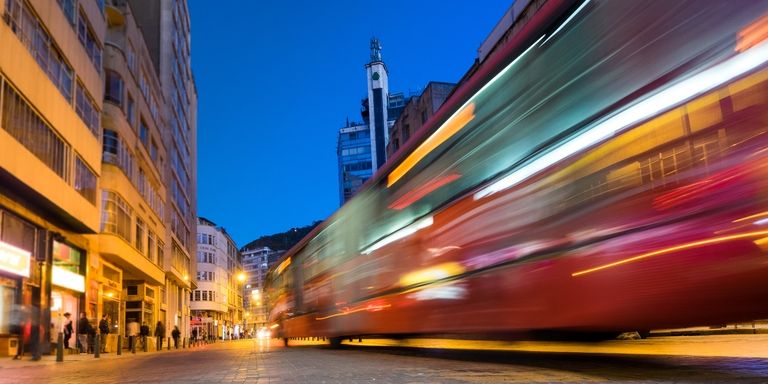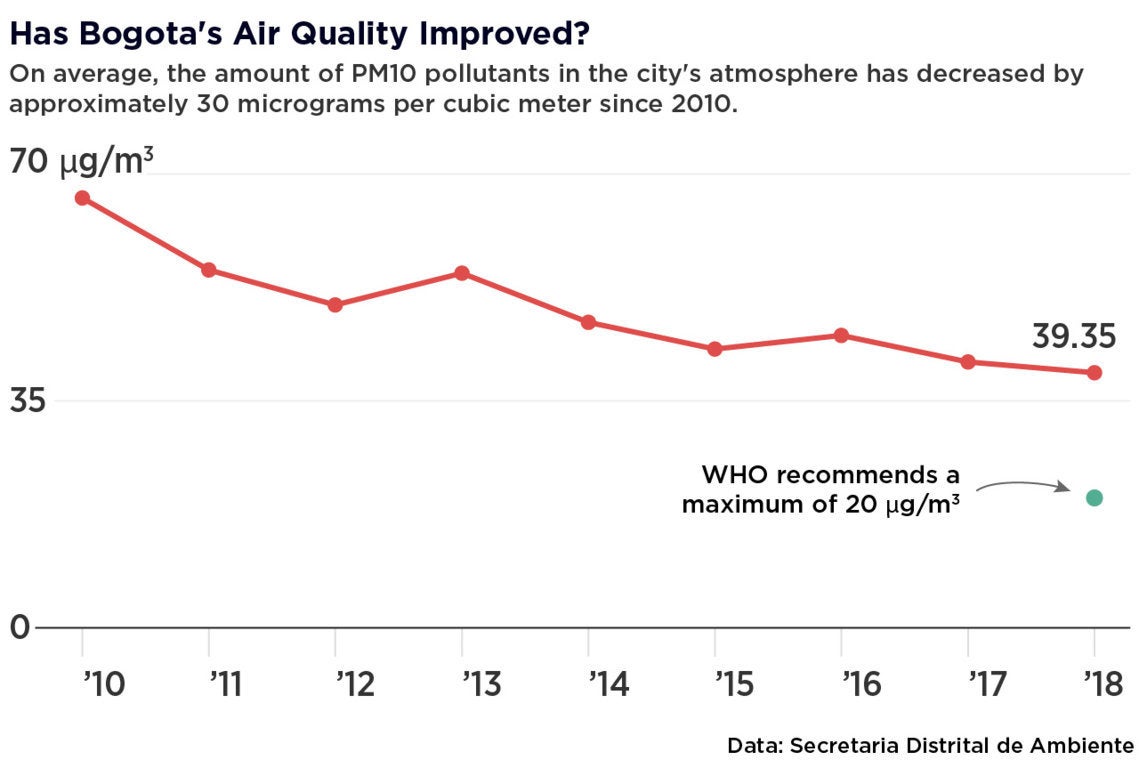
Superlatives are enough to define Bogota as one of the largest and most dynamic cities in Latin America and the Caribbean. Its more than 8 million inhabitants make around 15 million trips every day and contribute almost a quarter of the total to the Colombian economy. Today, four out of every ten commutes are made by public transport, which would represent almost five million trips per day in one of the fastest growing metropolises in the region.
One of the main challenges of Bogota, besides improving the quality of its public transport, is to reduce its air pollution. Air quality has become a priority issue, especially after the city issued an unusual environmental alert in March of this year—at least nine points of the city marked high levels of pollution.
Although the alert was the product of unfavorable meteorological factors, the role of buses and automobiles is still crucial. Today, Bogota has 8,695 buses in circulation whose toxic emissions pollute the air and cover the city under a dense layer of smog. Even when the problem is generally invisible, the numbers do not lie: the annual average of pollutant particulate matter in Bogota’s air is 39 micrograms per cubic meter, while the maximum recommended by the World Health Organization (WHO) is only 20.

However, not everything is bad news. Bogota is far less polluted than other cities in the region such as Lima, Monterrey and Santiago de Chile, all of them with high levels of air pollutants. Their annual average of PM10—a type of particulate matter, high in pollutants—is 88, 86 and 64 micrograms per cubic meter respectively, according to data obtained by the WHO.
So, how do you start cleaning the air? The strategy of Bogota has been to bet on the bicycle. More than 635,000 trips—4.28% of the total—are made every day through this means of transport, which today has 500 kilometers of cycle-infrastructure that cross the entire city. Not for nothing the Colombian capital is today the city that has the largest number of bike paths in all of Latin America and the Caribbean.
However, public transport remains the preferred way to move around the city, followed by journeys on foot. As it happens in all the big cities of the world, buses are one of the biggest polluting sources. Therefore, in order to improve air quality, the current Bogota public transport fleet must migrate to a greener, more sustainable and environmentally-friendly one.
Bogota now has 361 new hybrid technology buses capable of carrying up to 80 passengers each. This result is partly due to a loan of 40 million dollars from the IDB, implemented under Bogota’s Integrated Public Transport System, which is helping to significantly reduce the greenhouse gases and particulate matter in the air of the Colombian capital. According to our estimates, each year these buses help reduce by 92,000 tons the carbon dioxide that currently exists in the air of Bogota.
*/What kind of sustainable infrastructure would you like to have in your city?Hybrid and electric busesPublic bicyclesCharging stations for electric carsMore green areas
But what happened after the incorporation of these new buses? Not only have they contributed to the residents breathing a cleaner air, but the project has impelled clean technologies to enter fully into the city’s public transportation system. It is expected that Transmilenio, the famous network of BRTs and the backbone of Bogota's transport, will have a less polluting fleet in a few months than the one running today.
"This is showing a commitment to an important issue, a serious one such as pollution. More serious than we think," says Natalia Sanz from our office in Bogota, where she works as a transportation specialist.
The demand for energy in Latin America and the Caribbean will skyrocket in the coming decades. Only in terms of electricity, the region will double its demand in the next two decades. Fueled by economic development, rapid urbanization and increasingly populated cities, Latin America and the Caribbean will have to face a host of challenges that are directly related to how we move through our cities. The objective? More public transport and less combustion of fossil fuels.
"Cities are generally acting by reaction. Medellin is buying electric buses because the air quality situation is unsustainable," says Natalia. "The same thing is happening here in Bogota. Some days when you get up and look out, the sky is completely gray. "
But beyond acting by reaction, cities should follow clear guidelines based on policies that seek to mitigate pollution in a preventive manner. "Countries should have a clear line on what the technologies to be used should be. It is the government that can make a social and economic analysis of the issue, and at the same time work with the private sector to achieve joint solutions," says Natalia.
Santiago de Chile, meanwhile, is one of the pioneer cities of the region in incorporate a cleaner fleet, consistent with the environmental problems suffered by Chilean capital. The first hybrid bus began operating in May 2015, while 200 electric buses will be incorporated into the transportation system in December of this year, along with another 490 that have hybrid technology. It will be the first city in the region to have a large fleet of electric buses within its public transportation system.
The green revolution is already underway. The implementation of more sustainable solutions for the development problems of Latin America and the Caribbean is a priority. Look at other projects that are helping to transform the region and make it more sustainable and resilient here.

